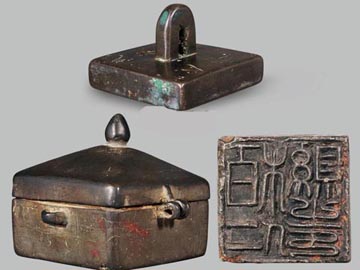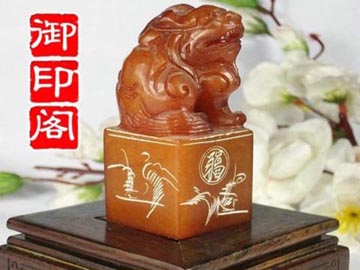|
The use of seals in the beginning was quite similar to the wax sealing of today. Before paper was invented, people could only write on bamboo slips. In order to keep the government documents and personal letters from being peeped at by others people used to tie the bamboo slips with strings. They cut a square hole at the knot, filled it with a stick clay ball, and pressed their seal on it. When drying up the clay ball became hard and was called “sealing clay”. After paper and silk were used seals were affixed on them.
For the last 3,000 years the seals played an important role in Chinese culture. The emperors, officials, and private people have used them widely. It is hard to say when the seal first appeared in China. The earliest examples of seals came from the Shang Dynasty (1,600BC-1,100BC), which were found from the archeological sites at Anyang, Henan Province. According to some funny stories, the first seal was given to the Yellow Emperor (2,600BC-1,600BC) by a yellow dragon and the one was given to Emperor Yao (2,600BC-1,600BC) by a phoenix. In any case, the receipt of the seal signifies to be given the mandate by Heaven to rule the country.
 |
 |
Imperial
Seal |
Official
Seal |
After China was unified by Emperor Qinshihunag in 221BC, he ordered to carve a piece of fine jade into one imperial seal, which was called xi. The seal with a handle in the shape of dragon and it was engraved with the inscription: “receive the order from heaven, enjoy long live and prosperity”. The imperial seal became the token of supreme imperial power and authority. According to the History of Tang Dynasty, Empress Wu (624AD-705AD) issued an order to change the word "xi" for imperial seal into "bao" because she disliked the fact that the word "xi" was close in sound with the "si" (death). But when Emperor Zhongzong resumed the throne in 705AD, he changed the name for imperial seals back to "xi". In subsequent dynasties the two words were alternately used. For the common people their seals were called "yinzhang" or "tuzhang".
Today seals are still used officially and privately. Many business people use specially designed seals as their Chinese name stamp, to indicate their reliability as business people and to confirm their identity.
The categories of Chinese seals
Imperial seals
In the Han Dynasty, the emperor had six imperial seals, during the Tang
he had eight, during the Ming (1368-1644AD) over a dozen, and by the time
of the Qing (1644-1911AD), there were several official imperial seals.
In the Forbidden City exhibited 25 pieces of imperial seals collected
by Emperor Qianlong (1736-1795AD) for different purposes.
Another type of imperial seal was a seal that the emperor used to indicate
that a certain document was written in his own handwriting. Emperor Qianlong
(1736-1795) for example, was famous for his literary achievements, including
calligraphy, and had produced a large amount of works stamped with his
seal. When his calligraphy was carved into stone steles, the seal was
also copied onto the surface of the stone.
Yet another special seal was used by the emperors to appraise and appreciate
art. It was customary for collectors and connoisseurs of art to stamp
their seals on the surface of a scroll painting or calligraphy work. The
imperial seal was always affixed on the art collected by the imperial
household. Many famous paintings from the Forbidden City have seals of
different emperors on them.
Official seals
Official seals have been conferred to officials as a token of their office
and authority. These seals were usually small enough to be carried on
the official's belt. There were regulations as to the material and shape
of the handle of these seals: some had to be gold, some copper, some with
a handle in the shape of a turtle, some of a camel. Up to the Eastern
Han dynasty (25AD-220AD), the color of ink used to affix official seals
was regulated depending on the position of the owner, some officials had
to use green ink, some purple, some yellow and etc.
The calligraphy of the inscription have changed a great deal over the
long span of Chinese history. Approaching the Han dynasty, the characters
on the seal inscriptions tend to become thicker and more angular. From
the Sui dynasty (581-618), they become rounded and thinner, and during
the Song and Yuan periods we can witness the spectacular jiudie (nine-folded)
script. In the Qing period, most official seals are bilingual with the
Chinese inscription on the right side and the Manchu on the left.
Private seals
Private seals are naturally unregulated; therefore they show the largest
variety in content, shape, size, material and calligraphy. Despite of
their varied characteristics, they can still be categorized based on their
use.
Seals with names, pen names etc on them were used as a signature by people
in their private life. This is how artists sign their works and letters.
Chinese literati commonly used a number of different pen names so identifying
a person's name from a seal can be a profound and interesting work.
Collector seals were mainly used for the purpose of authenticating pieces
of art. Thus a seal of a famous collector or connoisseur would become
an integral part of a work of art and could further raise its value. Thus
in the course of several centuries, some famous Chinese paintings were
stamped by many different seals.
The rest of private seals can be categorized “leisure seals". The
inscription on these seals is usually a short text quoted from famous
poems, aphorisms, and idioms to indicate the owners’ spirits, wishes and
ambitions.
 |
 |
Private
Seal |
Seal
Carving |
Chinese seals carving
There are three ways to make a seal: carving, casting and clay-baking.
The materials used range from gold, copper, iron, jade, ivory, stone,
wood, porcelain to crystal and glass. Characters carved on seals could
be in relief or in intaglio. The script on the seals developed with the
evolution of Chinese characters over the past 3,000 years and displayed
different features of different times.
In the Qin and Han dynasty, zhuan or curly script was widely applied on
seal carving. That explains why the art of seal carving is still called
zhuanke anb also why zhuan script is also known in English as “seal character”.
From the Sui dynasty (581AD-618AD), they became rounded and thinner, and
during the Song (960AD-1279AD) and Yuan (1271AD-1368AD) periods jiudiezhuan
carving (nine-folded curly script) became popular. This kind of script
was spectacular but so complicated. In the Qing (1644AD-1911AD) period,
most official seals are bilingual with the Chinese inscription on the
right side and the Manchu on the left. Now there are many seal carving
styles in China.
People always combined the three forms of art: calligraphy, painting and
seal carving into one. Seal carving contains three aspects: calligraphy,
composition and handwork. A master seal engraver must be able to write
different styles of the Chinese scripts and arrange all the characters
in a perfect balance in a limited space. Sometimes the artist has to exaggerate
the thickness or thinness of a stroke, elaborately straighten or curve
it, or even deliberately deform an ideogram to create an artistic effect.
The engraver’s speed of carving, the strength of wrist and finger movement
rhythm is very important to the artistic value of the seal. The engraver
must be familiar with the materials of the seal. Then he can give a full
play his skill on carving to create the aesthetic artwork.
 |
 |
Personal
Seal A |
Personal
Seal B |
Seal carving is an integration of limitation and infinity. The seal carving
is a condensed art form and the spiritual content of which is more beyond
the seal itself. The meaning expressed is very delicate and abstruse.
Under the carving knives of outstanding seal engravers, dots, lines, raises,
concaves, sparsity, density, punching, and cutting have all become demonstrative
elements in a highly abstract form.
A good seal stamp on a Chinese calligraphy or painting work will give
the artwork a new look. A good Chinese painter or seal maker must be a
good Chinese calligrapher because both Chinese painting and seal carving
have the same origin in Chinese calligraphy. However, a good Chinese calligrapher
does not necessarily need to be a painter or seal maker.
If you have interest in carving your
personal seal we can help you. Please tell us your English name and we
can translate it into Chinese and carve it on the seal. Personal Seal
A and Personal Seal B are 3x3x7cm big. They are made of Shoushan jade
stone. It costs 50USD to carve your name and including shipping.